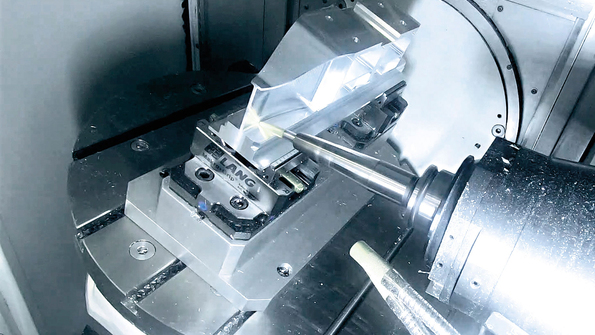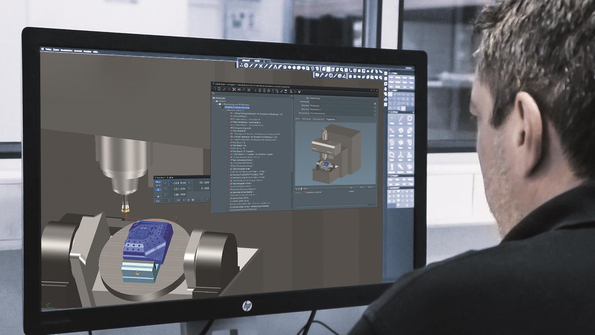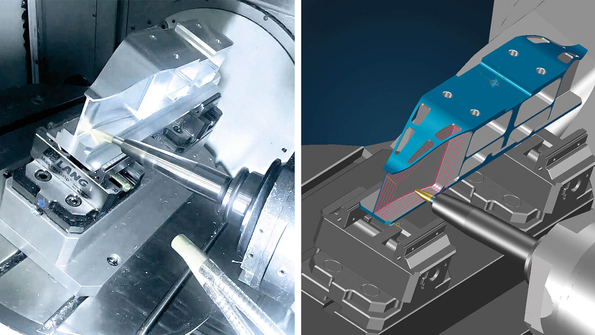Digital Twins in Manufacturing – Maximum Reliability in Automation
Easy error detection with simulation
The concept of the digital twin has been long-established in many industries and for many applications. In the production-related world of die, mold and machine manufacturing, this is understood to mean virtual planning and programming of the real manufacturing world. This enables simulation of the real manufacturing situation and the calculated toolpaths while sitting at a desk. Time-consuming and cost-intensive startup processes are eliminated. In the market environment of die and mold manufacturing, which is characterized by increasing competitive pressure, working with digital twins stands for faster and especially reliable manufacturing.
It's easy to get started: The market already has programs with the corresponding digital counterparts nearly for every milling machine. However, a standard solution is not enough for those wanting to ensure that their software supports them in eliminating the risk of an expensive and potentially hazardous collision. Among deviations that are not readily apparent, even the slightest differences can have serious consequences. It is therefore best to rely right from the start on a high-quality solution that is also viable for the future and that is continuously kept up to date by the manufacturer.
Detailed representation of the setup situation
A milling operation can also be a highly complex process involving the interaction of many parameters, such as material selection, data import, setup, etc. Put another way: The complete setup situation must be represented to the last detail. In addition to the actual milling machine, this includes all associated manufacturing resources. With this background, Tebis defines the digital twin as the representation of all actually existing manufacturing resources and processes in the software. The real manufacturing situation is preplanned 1:1 in the virtual world – regardless of whether the digital twin is for a common milling machine or an extremely complex setup situation.
The special Tebis approach
Tebis equipped the very first full version of its software with postprocessors. The virtual machine library has long been integrated. Over time, digital twins became more detailed with the increasing spread of the "digital twin" concept. For tools, it started with the simple milling cutter, followed by component-based milling and drilling tools and, in a subsequent step, component-based 3D turning tools. In addition to digital twins for tools, Tebis represents over 1,400 virtual models in 3,700 variants of all common machine types on the market in its machine library. The respective geometric and kinematic properties are also stored there. Tebis also has its own unit library for additional equipment such as jaw chucks, steady rests and tips as well as machine tables, attachments and partitions. Even virtual clamping devices are part of this CAD/CAM system.
Tebis takes a very special approach to perform the simulations as precisely as possible. The simulator is fully integrated in the CAD/CAM environment. The simulation and collision checking are performed already during NC programming. The method of checking the toolpaths for collisions and if necessary also correcting them in the CAM environment before NC output noticeably increases reliability and shortens change iterations if collisions are detected. This method especially also represents an ideal basis for reduced-personnel or unattended manufacturing over weekends. Especially for the latter case, it is essential that all machines run without interruption.
Digital process representation by MES
Not only the milling, laser cutting or turning process can now be implemented fully digitally and highly automated – the same also applies for the associated processes of planning, processing and control. An integrated MES solution (manufacturing execution system) cannot be avoided by companies wanting to establish a sustainable basis for Industry 4.0 in this context. Anyone looking for a suitable tool should be sure to select an MES solution that has been specifically developed for manufacturing companies. Tebis is positioning itself as a proven industry partner on the way to Industry 4.0 and therefore already included its own MES solution in its portfolio some time ago. ProLeiS MES stores the manufacturing environment and manufacturing knowledge in templates and stores results from past projects. The software also represents all further relevant data like bills of materials, availability of resources or manufacturing time. All order processes can be managed with ProLeiS. These processes refer to material logistics as well as the respective internal company deadlines and the deadlines of suppliers and service providers. All manufacturing-related processes can be mapped digitally In a modern MES. Comparable to a "digital twin of manufacturing", this software enables the highest efficiency of order control.
The MES software also enables forward-looking planning – it links the data from machines, storage locations and empirical values. Machine data acquisition generates a digital shadow. ProLeiS uses this to compare the remaining service life of the tools. If a replacement tool is needed, the machine operator receives a corresponding message sufficiently in advance and can automatically generate the corresponding order with a mouse click.
These two examples show how manufacturing-related companies can draw on the potential of Industry 4.0, which also includes meaningfully digitalizing and linking processes, and realize this within a reasonable time. As is so often the case in the business world, the basic selection of the system is critically important – the more sustainable the software, the greater the added value.
A digital twin is the digital simulation of reality. In specific terms, this corresponds to the digital representation of a machine with a geometrically correct appearance and its actual kinematic properties.
In contrast, the digital shadow is an evaluated collection of data, i.e. a data-reduced representation of reality. This means that it only accounts for the relevant production and process data (machine status, idle times) to provide information on past and current conditions in real time. It also serves as a basis for evaluation for forecasts. The structured combination of data from different sources enables predictive planning of machine capacities, predictive supply of tools on the machine and dynamic adjustment of manufacturing planning in real time





